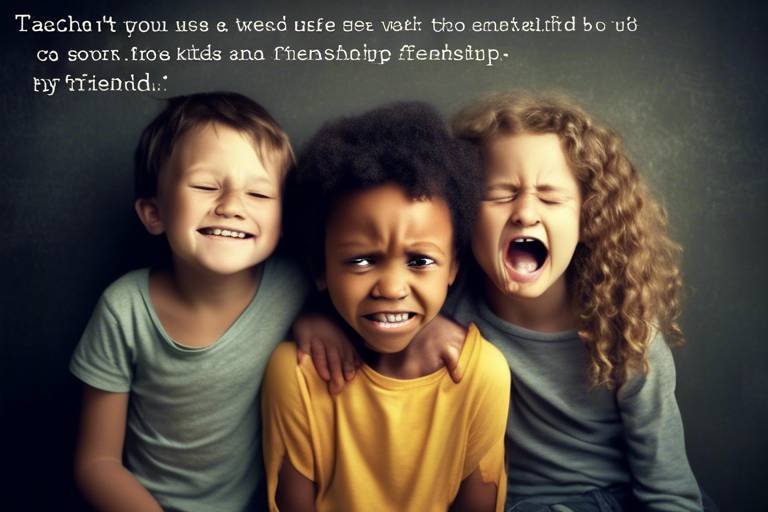Setting Kids Up for Success: The Art of Problem Solving
In today's fast-paced world, the ability to solve problems effectively is more crucial than ever, especially for our children. As parents and educators, we have the profound responsibility of nurturing these essential skills from a young age. But what does it really mean to cultivate problem-solving skills? It’s not just about teaching kids to find answers; it’s about encouraging them to approach challenges with a sense of curiosity and resilience. Imagine a child facing a puzzle: instead of simply providing the solution, we want to inspire them to explore different strategies, learn from their mistakes, and ultimately, feel empowered to tackle any problem that comes their way. This article delves into the myriad ways we can set our kids up for success by honing their problem-solving abilities, ensuring they thrive not just in school, but in life.
Why should we prioritize problem-solving skills in our children? Well, consider this: problem-solving is a fundamental life skill that transcends academics. It’s woven into the fabric of everyday life, from navigating social interactions to making decisions about future careers. Children equipped with strong problem-solving abilities are more likely to be independent thinkers, capable of analyzing situations and making informed choices. These skills not only enhance academic performance but also boost self-esteem and confidence. When children learn to approach problems systematically, they develop a toolkit for life—one that prepares them for the inevitable challenges they will face as they grow. So, how can we make problem-solving a natural part of their learning experience?
Fostering critical thinking in children is like planting seeds in a garden; with the right care, they will flourish into strong, independent thinkers. Encouraging kids to think critically helps them develop the analytical skills necessary for effective problem-solving. One of the best ways to promote this is through questioning techniques that stimulate their curiosity and creativity. By asking thoughtful, open-ended questions, we can lead children to explore problems from various angles, sparking their imagination and innovation.
Utilizing effective questioning techniques can significantly enhance a child's ability to think critically. For instance, when faced with a problem, instead of asking, “What is the answer?” try asking, “What do you think might happen if…?” This shifts the focus from finding a single solution to exploring multiple possibilities. Such questions encourage children to articulate their thoughts and reasoning, promoting a deeper understanding of the problem at hand.
Open-ended questions are particularly effective in nurturing critical thinking. These questions do not have a straightforward answer, allowing children to express their thoughts freely. For example, asking, “How would you solve this problem?” invites children to engage in a dialogue about their thought process, fostering a richer understanding of the challenges they face.
Another powerful method is guided discovery, where children navigate challenges with the support of an adult. This technique encourages them to approach problems systematically, building confidence as they learn to break down complex issues into manageable steps. By guiding them through the discovery process, we help them develop a sense of ownership over their learning and problem-solving strategies.
Collaboration among peers is a fantastic way to enhance problem-solving skills. When children work together, they share perspectives, brainstorm solutions, and learn the value of teamwork. This collaborative spirit not only enhances their ability to solve problems but also fosters social skills and empathy. Imagine a group of kids tackling a project together; they learn to respect differing opinions and understand that multiple viewpoints can lead to innovative solutions.
Applying problem-solving skills to real-world scenarios helps children grasp the relevance of these skills in their daily lives. Whether it’s through project-based learning or community involvement, engaging children in practical activities allows them to tackle real-life problems, fostering creativity and critical thinking. For instance, participating in a community clean-up project not only teaches them about environmental responsibility but also encourages them to identify local issues and collaboratively find solutions.
Engaging children in project-based learning is a dynamic way to cultivate problem-solving skills. This approach allows them to tackle real-life problems, encouraging creativity and critical thinking while developing practical solutions. For example, a class project on building a sustainable garden can teach kids about environmental science, teamwork, and the importance of planning and executing a project from start to finish.
Encouraging community involvement provides children with opportunities to identify local issues and work collaboratively to find solutions. This not only enhances their problem-solving skills but also instills a sense of responsibility and connection to their community. By engaging in activities such as volunteering or participating in local events, children learn that their actions can have a positive impact, reinforcing the value of teamwork and collaboration.
Teaching children to embrace challenges and setbacks as part of the problem-solving process is crucial for building resilience. Life is full of obstacles, and preparing our kids to face these with confidence and determination is one of the greatest gifts we can give them. When children learn that failure is not the end but rather a stepping stone to success, they develop a growth mindset that will serve them well throughout their lives. Encouraging them to reflect on their experiences, learn from their mistakes, and persist in the face of adversity equips them with the tools they need to navigate future challenges with grace.
- How can I encourage my child to be more independent in problem-solving?
Start by allowing them to tackle small challenges on their own. Offer support when needed, but resist the urge to provide immediate solutions. - What are some effective activities to promote problem-solving skills?
Engage your child in puzzles, games, and real-life scenarios that require critical thinking and collaboration. - How can I help my child learn from their mistakes?
Encourage open discussions about what went wrong and what could be done differently next time. This reflection is key to developing resilience.

The Importance of Problem Solving Skills
In today’s fast-paced world, problem-solving skills are more crucial than ever for children. These skills serve as the backbone for navigating the complexities of life, both in school and beyond. Imagine a child facing a challenging math problem or a social conflict with friends. How they approach these situations can shape their future success. Problem-solving isn’t just about finding the right answer; it’s about developing a mindset that embraces challenges and seeks solutions.
Why should parents and educators prioritize these abilities? First, problem-solving skills enhance critical thinking, allowing kids to analyze situations, weigh options, and make informed decisions. This analytical approach is invaluable, whether they're tackling a tough homework assignment or determining the best way to resolve a disagreement. Furthermore, children equipped with strong problem-solving skills are often more resilient. They learn that setbacks are merely stepping stones to success rather than insurmountable obstacles.
Additionally, fostering these skills can lead to better academic performance. Studies show that students who engage in problem-solving activities tend to excel in subjects like math and science. This correlation highlights the importance of integrating problem-solving into everyday learning experiences. When children practice these skills regularly, they become adept at applying them in various contexts, making them more versatile learners.
Moreover, problem-solving skills are essential for personal development. They help children develop emotional intelligence by understanding their feelings and the feelings of others, which is crucial for effective communication and relationships. When kids learn to approach problems thoughtfully, they become better equipped to handle life's challenges, such as peer pressure or family issues.
To summarize, the significance of problem-solving skills in children's development cannot be overstated. These skills foster critical thinking, enhance academic performance, build resilience, and promote emotional intelligence. As parents and educators, it’s our responsibility to cultivate these abilities in children, ensuring they are well-prepared for the future. By embedding problem-solving into daily activities, we can help them thrive in various aspects of life.
- Why are problem-solving skills important for children?
Problem-solving skills help children navigate challenges, enhance critical thinking, and build resilience, which are essential for academic and personal success. - How can I encourage my child to develop these skills?
Encourage open-ended questions, engage in project-based learning, and promote collaborative activities to help your child practice problem-solving in real-world scenarios. - What role does failure play in problem-solving?
Failure is a natural part of the learning process. Teaching children to embrace setbacks helps them develop resilience and a growth mindset.

Encouraging Critical Thinking
Fostering critical thinking in children is like planting a seed that will grow into a robust tree of knowledge and understanding. When kids learn to analyze, evaluate, and create, they are not just solving problems; they are developing a mindset that will serve them throughout their lives. So, how do we cultivate this vital skill in young minds? It starts with encouraging them to ask questions, think independently, and challenge assumptions. We want our children to be like detectives, piecing together clues and coming up with their own conclusions.
One effective way to stimulate critical thinking is through questioning techniques. Instead of simply providing answers, we can create an environment where children feel comfortable asking questions and exploring different perspectives. For instance, when discussing a story, instead of asking, "What happened next?" we could ask, "Why do you think the character made that choice?" This shifts the focus from rote memorization to deeper analysis, encouraging children to think critically about the motivations and consequences of actions.
Utilizing effective questioning techniques can stimulate children's curiosity and creativity, leading them to explore problems from different angles and develop innovative solutions. By incorporating open-ended questions into conversations, we can encourage children to articulate their thoughts and feelings more deeply. These questions don't have a simple yes or no answer, which allows for richer discussions. For example, asking "What do you think about this situation?" opens the door to a variety of responses and encourages children to express their opinions freely.
Open-ended questions are like keys that unlock the door to a child's imagination. They invite children to delve deeper into their thoughts and feelings. Instead of just recalling facts, they have to think critically about their responses. This practice not only enhances their understanding of the subject matter but also builds their confidence in expressing themselves. Imagine a child pondering, "What would happen if we changed the ending of this story?" This simple question can lead to a creative exploration of narrative possibilities.
Another method to encourage critical thinking is through guided discovery. This approach allows children to navigate challenges with support, helping them learn to approach problems systematically while building confidence. When faced with a problem, instead of giving them the answer, we can guide them with hints and prompts. For example, if a child is struggling with a math problem, instead of solving it for them, we might ask, "What strategies have you tried so far?" This technique helps children develop their problem-solving skills while feeling supported in their learning journey.
In essence, encouraging critical thinking is about creating a rich environment where children feel empowered to explore and question the world around them. By employing questioning techniques and promoting guided discovery, we can help them build a strong foundation for effective problem-solving. These skills will not only enhance their academic performance but also prepare them for life's challenges, making them more resilient and adaptable individuals.

Questioning Techniques
When it comes to nurturing problem-solving skills in children, questioning techniques play a pivotal role. Think of questions as the keys that unlock the doors to a child's mind, allowing them to explore, discover, and understand the world around them. By asking the right questions, we can ignite their curiosity and encourage them to think critically. So, how can we effectively engage our young learners? Let's dive into some powerful techniques that can transform the way children approach problems.
First and foremost, utilizing open-ended questions is crucial. These types of questions don’t just elicit a simple "yes" or "no" answer; instead, they invite children to express their thoughts and feelings in a more profound way. For example, instead of asking, “Did you like that book?” you might say, “What did you think about the main character’s choices?” This approach encourages children to reflect on their experiences and articulate their reasoning, promoting a deeper understanding of the subject matter.
Another effective method is guided discovery. This technique involves leading children through a problem while providing them with the necessary support to navigate challenges. Imagine you’re on a treasure hunt, but instead of giving away the treasure’s location, you offer clues that help them figure it out on their own. This not only builds their confidence but also teaches them to approach problems systematically. For instance, if a child is struggling with a math problem, instead of providing the answer, you might ask, “What steps do you think we should take first?” This encourages them to think critically about the process rather than just the solution.
Moreover, questioning techniques can also be enhanced through collaborative discussions. When children work together, they can share their perspectives and brainstorm solutions collectively. This collaborative environment fosters a sense of community and allows them to learn the value of teamwork. For example, you could pose a question like, “How can we solve this problem together?” This not only engages their problem-solving skills but also promotes social interaction, making learning a fun and enjoyable experience.
In summary, questioning techniques are essential tools in the art of problem-solving for children. By incorporating open-ended questions, guided discovery, and collaborative discussions, we can create an engaging learning environment that encourages critical thinking and creativity. Remember, the goal is not just to find the right answers but to foster a mindset that embraces curiosity and exploration. So, let’s keep those questions coming!
- Why are questioning techniques important for children? Questioning techniques help stimulate curiosity, encourage critical thinking, and promote deeper understanding, which are essential for effective problem-solving.
- How can I encourage my child to ask questions? Model curiosity yourself, ask open-ended questions, and create a safe environment where they feel comfortable expressing their thoughts.
- What role does collaboration play in problem-solving? Collaboration allows children to share ideas, learn from one another, and develop teamwork skills, all of which enhance their problem-solving abilities.

Open-Ended Questions
Open-ended questions are a powerful tool for fostering a child's ability to think critically and creatively. Unlike closed questions, which often lead to simple yes or no answers, open-ended questions invite children to explore their thoughts and feelings in depth. Imagine you're on a treasure hunt; the more clues you discover, the more paths you can take. That's what open-ended questions do—they unlock a world of possibilities, encouraging children to dive deeper into their understanding of a problem.
For instance, instead of asking, "Did you like the book?" you might ask, "What part of the book resonated with you the most, and why?" This type of question prompts children to reflect and articulate their thoughts, leading to richer discussions and a better grasp of the material. It helps them to not only express their opinions but also to back them up with reasons, which is crucial in developing their analytical skills.
Additionally, open-ended questions can be a fantastic way to spark creativity. When children are asked, "How would you solve this problem?" or "What would happen if...?" they're encouraged to think outside the box. These questions can lead to innovative solutions and unique perspectives. They can even help children to connect different concepts, much like how a spider weaves a web, forming connections that strengthen their overall understanding.
Moreover, incorporating open-ended questions into daily conversations can create a culture of inquiry at home or in the classroom. Parents and educators can model this by regularly asking questions that require more than a one-word answer. Here are some examples of open-ended questions you might consider:
- What do you think would happen if we didn't have rules?
- Can you describe a time when you faced a challenge and how you overcame it?
- What are some different ways we could approach this problem?
- How would you explain this concept to someone who doesn't understand it?
By integrating these types of questions into everyday discussions, we not only help children to develop their problem-solving skills but also nurture their confidence in expressing themselves. They learn that their opinions matter and that it's okay to explore different viewpoints. This process is vital for their growth, as it equips them with the tools they need to tackle challenges head-on.
In conclusion, open-ended questions are not just a means of gathering information; they are a gateway to deeper understanding and critical thinking. By encouraging children to engage with these questions, we empower them to become more effective problem solvers, ready to take on the world with curiosity and creativity.

Guided Discovery
Guided discovery is a powerful approach that empowers children to explore problems with a sense of autonomy while still providing the support they need. Imagine your child as a little detective, equipped with a magnifying glass, ready to uncover the mysteries of the world around them. This method encourages kids to ask questions, experiment, and draw conclusions without simply being handed the answers. Instead of direct instruction, parents and educators can act as facilitators, guiding children through the problem-solving process.
One of the key benefits of guided discovery is that it nurtures independent thinking. When children are allowed to explore a problem on their own, they learn to trust their instincts and develop their unique problem-solving strategies. For instance, if a child is faced with a puzzle, instead of showing them how to solve it, you might ask them questions like, “What do you think might work here?” or “Can you think of another way to approach this?” This kind of questioning not only stimulates their curiosity but also encourages them to think critically about the problem at hand.
Guided discovery also fosters a sense of confidence in children. As they navigate challenges with your support, they learn to approach problems systematically. It’s like giving them a roadmap for their journey. They may not know the destination at first, but with your guidance, they can find their way. This method allows children to experience the thrill of discovery, reinforcing the idea that making mistakes is a natural part of learning. When they encounter a setback, they can reflect on what went wrong and adjust their approach, building resilience in the process.
To implement guided discovery effectively, consider these strategies:
- Encourage Exploration: Allow children to explore different materials or concepts related to the problem. This could mean using blocks to understand balance or drawing to visualize a problem.
- Ask Thought-Provoking Questions: Use open-ended questions to prompt deeper thinking. Questions like, “What do you think will happen if…?” can lead to exciting discoveries.
- Provide Appropriate Challenges: Ensure that the problems presented are neither too easy nor too difficult, as this balance is crucial for maintaining engagement and promoting learning.
Incorporating guided discovery into everyday activities can be incredibly rewarding. Whether it’s cooking together and discussing measurements, engaging in a science experiment, or solving a mystery in a story, the possibilities are endless. By creating an environment where children feel safe to explore and make mistakes, you set them up for success not just in problem-solving but in life.

Encouraging Collaboration
Collaboration is like the secret sauce that makes problem-solving not only effective but also enjoyable for children. When kids work together, they learn to share ideas, listen to different perspectives, and develop a sense of community. This collaborative environment fosters creativity and enhances their ability to tackle challenges. Think of it as a team sport; when everyone plays their part, the whole team benefits. So, how can we encourage this spirit of collaboration in our young learners?
One effective way to promote collaboration is through group activities that require teamwork. For instance, setting up a project where children must build something together—be it a model, a garden, or even a simple game—can ignite their collaborative skills. During these projects, they will naturally encounter problems that require group brainstorming and collective problem-solving. This not only helps them learn how to communicate effectively but also teaches them the importance of compromise and negotiation.
Another fantastic method to encourage collaboration is through peer mentoring. Pairing older children with younger ones can create a dynamic learning environment. The older kids can share their knowledge and strategies, while the younger ones bring fresh perspectives and ideas. This mutual exchange enriches both parties and reinforces the idea that everyone has something valuable to contribute.
Additionally, incorporating technology can also enhance collaborative efforts. Digital platforms allow children to work together on projects, even if they are not in the same physical space. Tools like online whiteboards or collaborative document editors can help them share their ideas and work on solutions in real-time. This not only builds their problem-solving skills but also prepares them for a future where remote collaboration is increasingly common.
To wrap it up, fostering a collaborative environment is vital for developing problem-solving skills in children. Whether through group projects, peer mentoring, or the use of technology, encouraging collaboration helps children learn to value teamwork and appreciate the diverse perspectives of their peers. After all, when they work together, they can achieve so much more than they could alone!
- Why is collaboration important for children? Collaboration teaches children to work as a team, improving their communication skills and helping them understand different viewpoints.
- How can I encourage my child to collaborate with others? Engage your child in group activities, encourage peer mentoring, and provide opportunities for collaborative projects.
- What role does technology play in collaboration? Technology can facilitate collaboration by allowing children to work together remotely and share ideas in real-time.

Real-World Problem Solving
When it comes to , the rubber truly meets the road. It's one thing to solve a math problem on paper, but it's an entirely different ballgame when those skills are put to the test in everyday life. Children need to see the relevance of their problem-solving skills beyond the classroom walls. This is where practical application comes into play. By engaging kids in activities that mirror real-life challenges, we not only enhance their critical thinking but also prepare them for the complexities of adult life.
One effective way to introduce children to real-world problem solving is through project-based learning. This method allows kids to dive into projects that require them to tackle genuine issues. For instance, a project could involve creating a community garden which not only teaches them about botany but also about teamwork, planning, and the environment. The beauty of project-based learning lies in its ability to foster creativity and critical thinking, as children brainstorm and implement practical solutions to the challenges they encounter.
Additionally, involving children in community projects can significantly enhance their problem-solving skills. When kids participate in community service or local initiatives, they get a firsthand look at the issues that affect their neighborhoods. For example, they might identify a lack of recreational spaces for youth and work together to propose solutions, such as organizing events or advocating for new park facilities. This not only teaches them about social responsibility but also instills a sense of accomplishment when they see their ideas come to fruition.
To illustrate the impact of real-world problem solving, consider the following table that outlines some common community issues and potential projects that children can undertake:
| Community Issue | Potential Project |
|---|---|
| Lack of Green Spaces | Organizing a community garden |
| Food Insecurity | Starting a food drive |
| Environmental Pollution | Conducting a neighborhood clean-up |
| Limited Youth Activities | Creating a sports league |
By engaging in these types of activities, children not only learn how to identify problems but also how to work collaboratively with others to develop solutions. They gain invaluable experiences that help them understand the importance of community, teamwork, and the impact of their contributions. Furthermore, these experiences can be incredibly rewarding, as children see the difference they can make in their surroundings.
In conclusion, real-world problem solving is an essential skill that can be nurtured through hands-on experiences and community involvement. By providing children with opportunities to tackle real-life challenges, we equip them with the tools they need to navigate the complexities of life confidently. So, let’s encourage our kids to step out of their comfort zones and take on the world, one problem at a time!
Q: How can I encourage my child to be more involved in problem solving?
A: Start by introducing them to project-based learning and community involvement opportunities. Encourage them to participate in local initiatives or organize small projects at home or school.
Q: What are some effective ways to teach problem-solving skills?
A: Use real-life scenarios, ask open-ended questions, and promote critical thinking through guided discovery. Engaging them in discussions about their thought processes can also be beneficial.
Q: Why is collaboration important in problem solving?
A: Collaboration allows children to share diverse perspectives, brainstorm solutions, and learn the value of teamwork. It helps them understand that two (or more) heads are often better than one!

Project-Based Learning
Project-Based Learning (PBL) is a dynamic classroom approach in which students actively explore real-world problems and challenges. This method not only engages children but also equips them with essential skills they will carry into adulthood. Imagine your child working on a project that not only sparks their interest but also requires them to think critically, collaborate with peers, and develop practical solutions. Sounds exciting, right?
In a PBL environment, children take the reins of their learning. They dive into projects that resonate with their interests and the world around them. For instance, they might work on a project to design a community garden, which involves researching plant types, understanding local ecosystems, budgeting for supplies, and even presenting their ideas to community members. This hands-on experience is invaluable, as it allows them to apply theoretical knowledge to practical situations.
One of the key benefits of Project-Based Learning is that it fosters creativity. When children are given the freedom to explore and create, their imaginations can run wild. They learn to ask questions, seek answers, and think outside the box. In a traditional classroom setting, students may often feel confined to textbooks and tests, but PBL breaks down those barriers. It encourages them to engage with the material in a way that is meaningful and relevant to their lives.
Moreover, PBL promotes teamwork. Children learn to communicate effectively, listen to others, and value different perspectives. They discover that collaboration can lead to innovative solutions that they might not have considered on their own. This teamwork aspect is crucial, as it mirrors real-life situations where working with others is often necessary to achieve a common goal.
To illustrate the impact of Project-Based Learning, consider the following table that highlights the key components and benefits:
| Component | Benefit |
|---|---|
| Real-World Problems | Increases engagement and relevance |
| Collaboration | Enhances teamwork and communication skills |
| Creativity | Encourages innovative thinking and problem-solving |
| Reflection | Promotes self-assessment and critical thinking |
As children navigate through their projects, they also learn the importance of reflection. After completing a project, they should take time to evaluate what worked, what didn’t, and how they can improve in the future. This practice not only reinforces their learning but also instills a growth mindset, which is essential for overcoming future challenges.
Incorporating Project-Based Learning into your child’s education can be as simple as encouraging them to pursue their interests through hands-on activities at home. Whether it’s a science experiment, a community service project, or even a creative arts endeavor, the possibilities are endless. By supporting their exploration, you’re not just helping them learn; you’re setting them up for lifelong success.
- What age group is Project-Based Learning suitable for?
Project-Based Learning can be adapted for all age groups, from preschoolers to high school students. The complexity of the projects can be adjusted based on the child's developmental level. - How can I implement PBL at home?
You can encourage PBL at home by allowing your child to choose a project that interests them, providing resources, and guiding them through the process without giving away solutions. - What subjects can benefit from Project-Based Learning?
PBL can be applied across various subjects, including science, math, social studies, and the arts. It’s a versatile approach that enhances learning in any discipline.

Community Involvement
Engaging children in is a powerful way to enhance their problem-solving skills while fostering a sense of responsibility and connection to their surroundings. When children participate in community activities, they are not just learning about the world around them; they are also discovering how they can make a difference. Think of it like planting a seed in a garden; with the right care and attention, that seed can grow into something beautiful and impactful.
Through community involvement, children learn to identify local issues and work collaboratively to find solutions. This real-world application of problem-solving skills is invaluable. For instance, when kids participate in a community clean-up, they not only see the problem of litter firsthand but also brainstorm ways to address it. This might involve organizing regular clean-up days or creating awareness campaigns about waste management. Such activities foster a sense of ownership and pride in their community, while also teaching them the importance of teamwork.
Moreover, community involvement can take many forms, including:
- Volunteering at local shelters: Children can learn empathy and the importance of giving back.
- Participating in neighborhood projects: Whether it's building a playground or planting trees, these activities encourage collaboration.
- Joining local clubs or organizations: This can help children develop leadership skills and learn to work with diverse groups of people.
In addition to developing problem-solving skills, community involvement teaches children about the interconnectedness of society. They begin to see how their actions can have a ripple effect, influencing others and contributing to the greater good. This understanding is crucial in today’s world, where challenges often require collective effort to solve. By working together, children learn that they are not alone in facing problems; they have a network of peers and mentors who can support them.
Furthermore, community involvement can also be a fantastic way for children to explore their interests and talents. For example, a child who loves art might help paint a mural in a local park, while another who enjoys science could participate in a community garden project, learning about sustainability and agriculture in the process. These experiences not only enhance their problem-solving skills but also allow them to discover their passions and strengths.
Ultimately, encouraging children to get involved in their communities is about more than just solving problems; it's about building a foundation for lifelong learning and growth. It teaches them that challenges are opportunities for innovation and that they have the power to effect change in their world. As they grow, these experiences will shape them into thoughtful, engaged citizens who are ready to tackle the complexities of life with confidence and creativity.
Q: How can I encourage my child to get involved in the community?
A: Start by exploring local events and organizations that align with your child's interests. Encourage them to join clubs or volunteer for projects that resonate with them. You can also participate together to make it a shared experience!
Q: What are some benefits of community involvement for children?
A: Community involvement helps children develop problem-solving skills, fosters empathy, builds teamwork abilities, and enhances their understanding of social responsibility. It also provides opportunities for them to explore their interests and develop new skills.
Q: Are there specific age-appropriate activities for community involvement?
A: Yes! Younger children can participate in simple activities like neighborhood clean-ups or community gardening. As they grow older, they can take on more responsibilities, such as organizing events or leading projects.

Building Resilience Through Challenges
In today's fast-paced world, teaching children to embrace challenges is like giving them a superpower. Resilience, the ability to bounce back from setbacks, is crucial for their overall development. When kids encounter difficulties, they often feel overwhelmed, but with the right guidance, these moments can transform into invaluable learning experiences. Think of resilience as a muscle; the more you use it, the stronger it gets. So, how can we help our little ones build this essential skill?
First and foremost, it's important to create an environment where challenges are seen as opportunities rather than obstacles. Encourage your children to take on tasks that may seem slightly out of their reach. This could be anything from tackling a challenging math problem to learning a new sport. When they face these challenges, they learn that it's okay to struggle. In fact, struggling is often the first step towards mastering a new skill. As parents and educators, we can guide them through this process by providing support while allowing them to take the lead.
Another effective strategy is to share stories of perseverance. Whether it's a personal anecdote or a well-known tale of someone overcoming adversity, these narratives can inspire children. For example, consider discussing famous figures like Thomas Edison, who famously said, "I have not failed. I've just found 10,000 ways that won't work." Such stories highlight that failure is not the end but rather a stepping stone to success. When children see that others have faced challenges and emerged victorious, they are more likely to adopt a similar mindset.
Additionally, we should encourage a growth mindset in our children. This concept, popularized by psychologist Carol Dweck, emphasizes that abilities and intelligence can be developed through dedication and hard work. When children understand that their efforts can lead to improvement, they are more likely to persist in the face of challenges. You can foster this mindset by praising their efforts rather than just the outcomes. For instance, instead of saying "Great job on your test!", try saying, "I’m proud of how hard you studied for that test!" This subtle shift in language can make a world of difference in how children perceive their abilities.
Moreover, teaching problem-solving skills plays a vital role in building resilience. When children encounter difficulties, guiding them through a structured approach to solving problems can empower them. Here’s a simple framework you can use:
| Step | Description |
|---|---|
| Identify the Problem | Help them articulate what the challenge is. |
| Brainstorm Solutions | Encourage them to think of multiple ways to tackle the problem. |
| Evaluate Options | Discuss the pros and cons of each solution. |
| Take Action | Support them as they implement their chosen solution. |
| Reflect | Afterward, talk about what worked and what didn’t. |
Finally, it's essential to model resilience ourselves. Children learn a great deal by observing the adults in their lives. When they see us facing challenges with a positive attitude, they are more likely to adopt similar behaviors. Share your own experiences of overcoming obstacles, and let them see how you handle stress and setbacks. This not only teaches them resilience but also strengthens your bond.
In conclusion, building resilience through challenges is not just about overcoming obstacles; it's about fostering a mindset that embraces growth and learning. By creating supportive environments, sharing inspiring stories, promoting a growth mindset, teaching problem-solving skills, and modeling resilience, we can equip our children with the tools they need to navigate life's ups and downs with confidence and determination.
- What is resilience? Resilience is the ability to recover quickly from difficulties; it's about bouncing back from challenges.
- How can I help my child become more resilient? You can help by encouraging them to face challenges, sharing stories of perseverance, and modeling resilient behavior yourself.
- Why is a growth mindset important? A growth mindset helps children understand that their abilities can improve with effort, making them more likely to persist through challenges.
- What role does problem-solving play in resilience? Problem-solving teaches children how to approach challenges systematically, empowering them to find solutions and learn from their experiences.
Frequently Asked Questions
- Why are problem-solving skills important for children?
Problem-solving skills are crucial for children because they help them navigate everyday challenges, both in school and in life. These skills foster independence, boost confidence, and enhance critical thinking, enabling kids to tackle issues creatively and effectively.
- How can I encourage critical thinking in my child?
You can encourage critical thinking by engaging your child in discussions that require them to express their opinions and reasoning. Use open-ended questions that stimulate their curiosity, and allow them to explore different perspectives on a problem. This not only promotes analytical skills but also builds their confidence in articulating their thoughts.
- What are some effective questioning techniques?
Effective questioning techniques include asking open-ended questions that cannot be answered with a simple 'yes' or 'no.' For example, instead of asking, "Did you like the story?" you might ask, "What did you think about the character's choices?" This encourages deeper thinking and discussion.
- How does collaboration enhance problem-solving skills?
Collaboration allows children to share their ideas and learn from one another. When kids work together, they can brainstorm solutions, challenge each other's thinking, and develop teamwork skills, which are essential for tackling complex problems in the future.
- What is project-based learning?
Project-based learning involves engaging children in hands-on projects that require them to solve real-life problems. This approach not only fosters creativity and critical thinking but also helps them apply their knowledge in practical scenarios, making learning more relevant and enjoyable.
- How can community involvement improve problem-solving skills?
Community involvement provides children with opportunities to identify local issues and work together to find solutions. This real-world application of problem-solving skills helps them understand the impact of their actions and fosters a sense of responsibility and community engagement.
- How can I help my child build resilience through challenges?
Teaching your child to view challenges as opportunities for growth is key to building resilience. Encourage them to embrace setbacks and learn from mistakes, reinforcing the idea that persistence and effort are essential components of successful problem-solving.



















